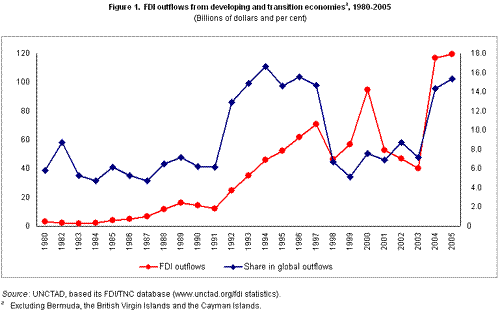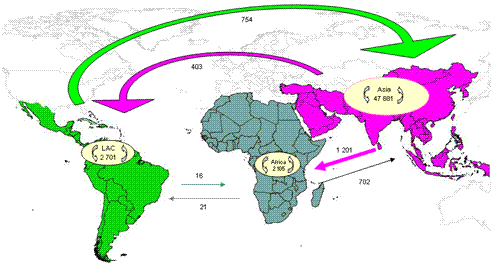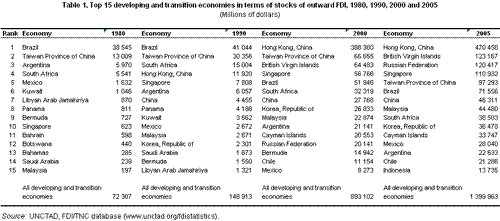| EMBARGO The contents of this press release and the related Report must not be quoted or summarized in the print, broadcast or electronic media before 16 October 2006, 17:00 GMT (1 PM New York, 19:00 Geneva, 22:30 Delhi, 02:00 - 17 October Tokyo) |
Foreign direct investment (FDI) from developing and transition economies reached a record level in 2005, according to the World Investment Report 2006, FDI from Developing and Transition Economies: Implications for Development (1). The report will be released on 16 October.
Most of these investments end up in other developing countries, contributing to "South-South" economic growth. In fact, many low-income countries now rely mainly on other developing countries for inward FDI. Appropriate policy responses in both source and recipient countries can increase the development gains from this trend, UNCTAD economists report.
Emerging sources of FDI
A number of developing and transition economies have recently surfaced as important home countries of FDI. Between 1990 and 2005, the number of such economies with outward stocks of FDI of more than US$5 billion increased from 6 to 25. Last year, transnational corporations (TNCs) based in developing or transition economies, but excluding major offshore financial centres, generated FDI outflows of $120 billion - the highest level ever recorded. (See figure 1) Asia accounted for almost 70% of these capital flows. The list of top developing country sources in 2005 was led by Hong Kong (China), the Russian Federation, Singapore, Taiwan Province of China, Brazil and China (see table 1).
The number of large TNCs from developing and transition economies is rising. While only 19 featured among the Fortune 500 in 1990, 47 such companies did in 2005. The top five TNCs from developing and transition economies are also among the top 100 global TNCs: Hutchison Whampoa (Hong Kong, China), Petronas (Malaysia), Singtel (Singapore), Samsung Electronics (Republic of Korea) and CITIC Group (China).
Major TNCs from all parts of the developing world, as well as from the transition economies, have emerged in the primary sector (oil, gas, mining) and resource-based manufacturing (metals, steel). Another TNC cluster is found in various non-tradable services and goods that are relatively difficult to export (e.g. cement, food and beverages). A third cluster of activities includes some that are the most exposed to global competition, such as automotives, electronics, garments and information technology (IT) services. Almost all the major TNCs from developing countries in these industries are based in Asia.
Factors behind the rise of developing country TNCs - and their implications
The boom in FDI from some developing and transition economies reflects the increasing competitiveness of many firms in these economies. The FDI surge has also partly been fuelled by soaring export revenues from manufactured products and natural resources in some countries, which have contributed to building up the financial strength needed to engage in overseas investment. Perhaps most importantly, firms from these economies have been increasingly affected by global competition. They have come to realize the growing importance of accessing international markets and connecting to global production systems and knowledge networks. Accordingly, their view of business has become far more international and their ambitions increasingly regional or global in scope.
"The rise of developing country TNCs is part of a burgeoning shift in the structure of the world economy" says Anne Miroux, Head of the World Investment Report team. "Although the future global map of business and economic power is not easy to predict, companies from Brazil, China, India and South Africa -- indeed from across the entire developing world -- will increasingly be household names. This is an exciting outlook from the development perspective, especially because these TNCs are also significant investors in other developing countries."
Policy responses boost the trend
The expansion of FDI from these new source economies has attracted some interest, especially from a number of investment promotion agencies (IPAs). More than 90% of African IPAs currently target FDI from other developing countries, notably from within their own region. Developed-country IPAs have also set up local offices in places such as Brazil, China, India, the Republic of Korea, Singapore and South Africa.
From the home country perspective, there is growing recognition that outward FDI can strengthen the competitiveness of firms. Only a handful of developing countries retain outright bans on outward FDI. In fact, some governments have even begun to encourage their firms to invest abroad by providing information, match-making services, incentives and investment insurance. However, the Report stresses that whether a country should move to "active promotion" of outward FDI depends on several factors, including the balance-of-payments situation of a country and the capabilities of its enterprise sector. Many low-income countries may be better advised to focus on creating a competitive business environment and enhancing firm capabilities at home, rather than promoting outward FDI.
South-South opportunities
According to the UNCTAD report, the expansion of FDI from developing countries is particularly relevant for South-South cooperation. Excluding offshore financial centres, total South-South flows shot up from $2 billion in 1985 to $60 billion in 2004, or 25% of all FDI inflows to developing countries. The bulk of South-South FDI is intraregional (See figure 2). In fact, for a number of least developed countries, FDI from developing home countries makes up a large or preponderant share of their total inward flows. For example, more than 50% of all FDI inflows in Botswana, the Democratic Republic of the Congo, Lesotho, Malawi and Swaziland come from South African investors.
"It is important to consider how this form of "South-South" cooperation can be further enhanced to promote development gains", comments U.N. Secretary-General Kofi Annan.
While developing-country TNCs may lag behind their developed-country counterparts in terms of technological assets and capabilities, their business models and competencies are sometimes better adapted to operating in developing host countries. Compared with developed-country TNCs, a key advantage of developing-country investors is their greater familiarity with the economic conditions of host developing countries. This makes it is easier for host countries to attract FDI from these firms. Smaller technological gaps between home and host-country firms also increase the chance of greater technological spillovers from foreign affiliates to firms in host countries.
Some developing home countries have set up dedicated programmes to boost South-South FDI. These efforts can be further explored and supported through closer collaboration among developing-country institutions. UNCTAD´s initiative to establish the "G-NEXID" network, which allows for the sharing of experiences among export-import (EXIM) banks from developing countries, is an important step in this direction.
More dialogue needed
Not all FDI has been well received in host countries.. Some cross-border mergers and acquisitions (M&As), especially in the energy sector, along with M&As in infrastructure services or other industries with a "security dimension," have raised concerns. TNCs from developing or transition economies need to be aware of the potential sensitivities of South-South investment flows. Clearly, host country concerns must be weighed against the potential benefits of having more companies competing to acquire local assets. Countries need to be careful in their decisions, keeping in mind the risk of fuelling possible retaliation and protectionism.
To mitigate risks and to enhance the benefits from increased FDI from developing and transition economies, UNCTAD urges countries to engage in more dialogue. South-South sharing of experiences may enhance opportunities for cross-border investments and contribute to the mutual development of home and host countries. From a South-North perspective, there is a similar need for dialogue, increased awareness and understanding of the factors that drive FDI from the South and of the potential impacts. UNCTAD and other international organizations can play an important role by providing analysis, technical assistance and -- not least -- fora for exchanging views and experiences, to help countries realize the full benefit of the increase in FDI from developing and transition economies.
| The World Investment Report and its database are available online at http://www.unctad.org/wir and http://www.unctad.org/fdistatistics |
ANNEX
Tables and figures
Figure 1. FDI Outflows from developing and transition economies, 1980-2005
Source: UNCTAD, World Investment Report 2006
Figure 2. Intraregional and interregional FDI flows in developing countries excluding offshore financial centres, average 2002-2004
Source: UNCTAD, World Investment Report 2006
.
Table 1. Top 15 developing and transition economies in terms of stocks of outward FDI
Source: UNCTAD, World Investment Report 2006



